Egypt is a country rich in religious history, where ancient traditions, architectural marvels, and sacred sites offer deep spiritual insights. From the towering temples dedicated to the gods of ancient Egypt to the awe-inspiring mosques of Cairo and the serene Christian monasteries of the Sinai Peninsula, the country is home to some of the world’s most significant religious landmarks. This journey through Egypt’s sacred spaces takes you through the grandeur of Karnak and Abu Simbel, the spiritual heart of Cairo’s Islamic mosques, and the tranquil beauty of the Coptic Christian monasteries. These sites not only showcase Egypt’s architectural brilliance but also provide a deep connection to its rich religious and cultural heritage. Whether you seek reflection, historical exploration, or spiritual renewal, Egypt’s sacred landmarks offer something profound for every visitor.
- Egypt Tour Magic
- Egypt Tour Packages
- Excursions in Egypt
- Cairo Tours and Excursions
- Hurghada Tours and Excursions
- Soma Bay Tours and Excursions
- Makadi Bay Tours and Excursions
- Sahl Hasheesh Tours and Excursions
- El Gouna Tours and Excursions
- Marsa Alam Tours and Excursions
- Port Ghalib Tours and Excursions
- El Quseir Tours and Excursions
- Dendera and Abydos Day Tours
- Aswan Tours and Excursions
- Luxor Tours and Excursions
- Alexandria Tours and Excursions
- Sharm El Sheikh Tours and Excursions
- Top Rated Tours in 2025
- Optional Excursions in Egypt
- Private Transfer
- Blogs About egypt
- Ancient Egypt
- What You Need To know Before Your First Trip To Egypt
- Best Places to Visit in Egypt 2025
- Top Attractions in Red Sea Resorts 2025
- Top 10 Tourist Activities in Egypt
- Top 30 Activities You Can’t Miss in Egypt
- The Guide to Guided Tours in Egypt
- Egypt’s Ancient and Modern History
- The Nile River
- The Deserts of Egypt
- Historical Sites in Egypt
- Cairo
- Alexandria
- Luxor
- Aswan
- The Red Sea
- Dendera Temple
- El Fayoum Oasis
- Bahariya Oasis
- Siwa Oasis
- Al Alamein
- Marsa Matruh
- Ancient Egyptian gods
- famous Egyptian dishes
- UNESCO World Heritage sites
- About Us
- Why Egypt Tour Magic
- Egypt Tour Magic
- Egypt Tour Packages
- Excursions in Egypt
- Cairo Tours and Excursions
- Hurghada Tours and Excursions
- Soma Bay Tours and Excursions
- Makadi Bay Tours and Excursions
- Sahl Hasheesh Tours and Excursions
- El Gouna Tours and Excursions
- Marsa Alam Tours and Excursions
- Port Ghalib Tours and Excursions
- El Quseir Tours and Excursions
- Dendera and Abydos Day Tours
- Aswan Tours and Excursions
- Luxor Tours and Excursions
- Alexandria Tours and Excursions
- Sharm El Sheikh Tours and Excursions
- Top Rated Tours in 2025
- Optional Excursions in Egypt
- Private Transfer
- Blogs About egypt
- Ancient Egypt
- What You Need To know Before Your First Trip To Egypt
- Best Places to Visit in Egypt 2025
- Top Attractions in Red Sea Resorts 2025
- Top 10 Tourist Activities in Egypt
- Top 30 Activities You Can’t Miss in Egypt
- The Guide to Guided Tours in Egypt
- Egypt’s Ancient and Modern History
- The Nile River
- The Deserts of Egypt
- Historical Sites in Egypt
- Cairo
- Alexandria
- Luxor
- Aswan
- The Red Sea
- Dendera Temple
- El Fayoum Oasis
- Bahariya Oasis
- Siwa Oasis
- Al Alamein
- Marsa Matruh
- Ancient Egyptian gods
- famous Egyptian dishes
- UNESCO World Heritage sites
- About Us
- Why Egypt Tour Magic
Exploring Egypt’s Sacred Landmarks: A Journey Through Ancient Temples, Islamic Mosques, and Christian Monasteries
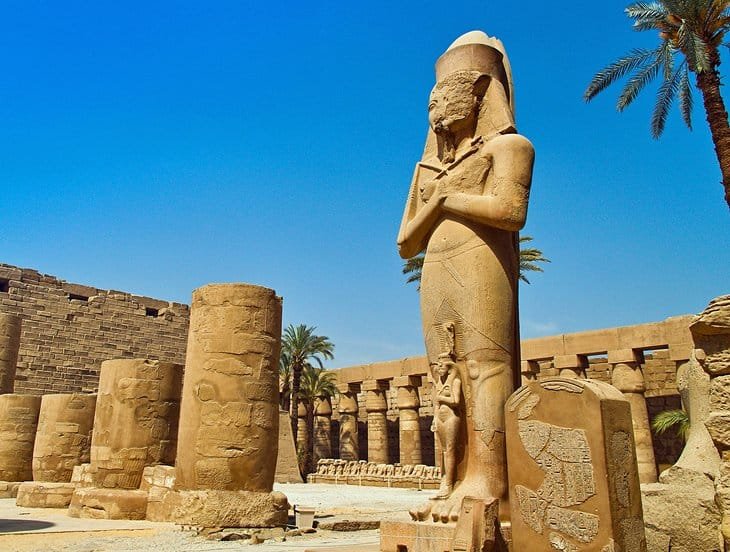
1. The Ancient Egyptian Temples and Monuments
The ancient Egyptians built monumental temples and structures that not only served as places of worship but also reflected the immense power of their pharaohs and their deep reverence for the gods. One of the most significant religious sites from ancient Egypt is the Karnak Temple Complex in Luxor, dedicated to the god Amun, the most powerful deity in ancient Egyptian religion. The scale and grandeur of Karnak are truly awe-inspiring. The temple’s vast layout, with its monumental pylons, towering columns, and impressive obelisks, showcases the architectural brilliance of ancient Egypt. The Hypostyle Hall at Karnak, which contains 134 massive columns, is one of the most iconic features, creating a space of both religious significance and architectural marvel. The temple complex was not only a place of worship but also a site where pharaohs and priests conducted rituals to ensure the favor of the gods and the prosperity of the kingdom. Karnak serves as a stunning testament to the ancient Egyptians’ religious devotion and their belief in the divine presence in every aspect of life. Another remarkable site is Abu Simbel, where two colossal temples were carved into the mountainside by Ramses II during the 13th century BC. The larger of the two temples, dedicated to Ramses II himself and the gods Amun, Ra-Horakhty, and Ptah, features four enormous statues of the pharaoh, each standing at 20 meters tall. The temple was built to assert Ramses II’s power and legacy, both as a king and a religious figure. The precision of the temple’s construction is evident in its alignment with the sun, which illuminates the temple's inner sanctum twice a year, a phenomenon that symbolizes the divine power that connects the ruler with the gods. Abu Simbel is an enduring symbol of Egypt’s ancient religious and political authority. While the Pyramids of Giza are not temples in the traditional sense, they are inextricably tied to ancient Egyptian religious beliefs. The pyramids were built as monumental tombs for the pharaohs, designed to protect their bodies and ensure their safe journey to the afterlife. The largest of these, the Great Pyramid of Khufu, reflects the Egyptians’ belief in immortality and their desire to maintain their connection to the gods after death. These stone structures were built with such precision and care that they were intended to serve as a bridge between the earthly realm and the divine, symbolizing the eternal power of the pharaohs and their continued worship after death. Together, the temples of Karnak, the colossal statues of Abu Simbel, and the Pyramids of Giza illustrate the profound relationship between religion, power, and culture in ancient Egypt, revealing how these structures were designed not only for practical purposes but also to honor the gods and secure the divine favor of the rulers.
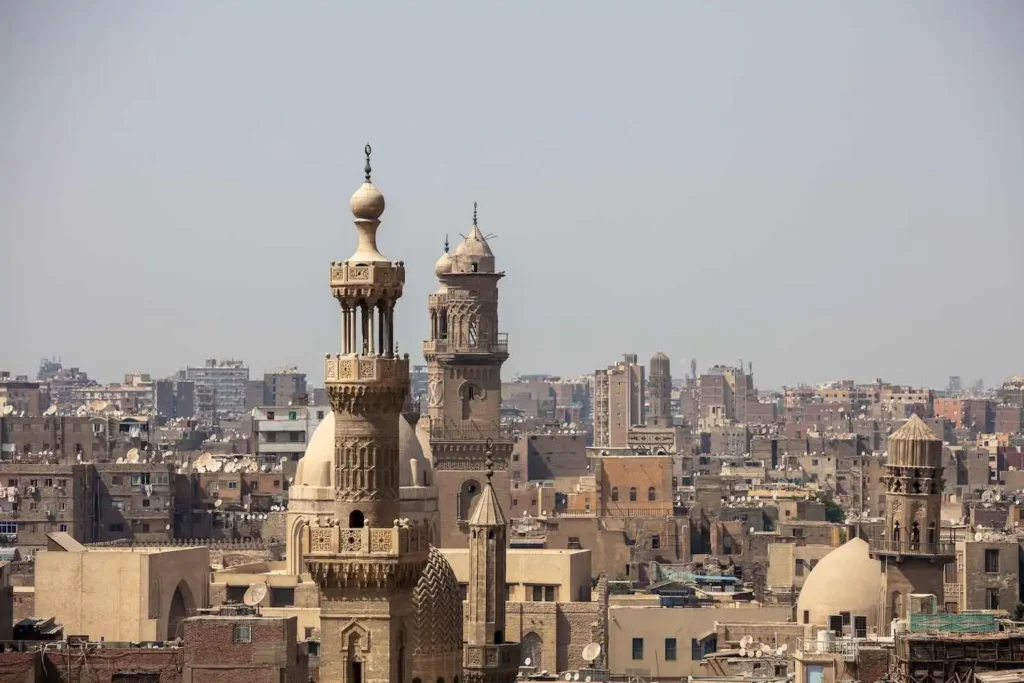
2. Islamic Cairo: A City of Mosques
Cairo, a city where the ancient and modern converge, is home to an array of stunning Islamic landmarks that reflect Egypt’s deep Islamic heritage. One of the most iconic structures in Cairo is the Mosque of Muhammad Ali, situated within the Citadel of Saladin. Built in the early 19th century by Muhammad Ali Pasha, the mosque is an impressive example of Ottoman-style architecture. Its grand dome and towering minarets dominate the city’s skyline, offering visitors panoramic views of Cairo and, on clear days, the distant Giza Pyramids. The mosque’s interior is equally captivating, with intricate designs and lavish decor that showcase the artistic beauty of Islamic architecture. The mosque not only serves as a major religious site but also stands as a symbol of Muhammad Ali Pasha’s power and his efforts to modernize Egypt. The combination of the mosque’s historical significance and its majestic appearance makes it a must-visit landmark for anyone exploring Cairo’s rich Islamic culture. Not far from the Mosque of Muhammad Ali is Al-Azhar Mosque, one of the oldest and most influential Islamic institutions in the world. Established in the 10th century, Al-Azhar Mosque has served as a center for Islamic scholarship and a place for religious worship. Attached to the mosque is Al-Azhar University, which is considered one of the oldest institutions of higher learning globally. For centuries, Al-Azhar University has been a hub for Islamic thought, shaping the intellectual and spiritual life of the Muslim world. Today, it continues to educate students from across the globe, making Al-Azhar a vital center for both religious and academic pursuits. The mosque itself is a stunning example of Fatimid architecture, with its wide courtyards, delicate minarets, and beautiful calligraphy adorning the walls. Another standout mosque in Cairo is the Sultan Hassan Mosque, an architectural masterpiece of the Mamluk period, built in the 14th century. The mosque’s design reflects the grandeur of Mamluk architecture, with a central courtyard that is vast and imposing, surrounded by a large prayer hall, and complemented by intricate tilework. The mosque's simple yet striking design, with a massive central dome and towering minarets, exemplifies the art and craftsmanship of Islamic Cairo. Sultan Hassan's mosque is particularly notable for its massive size and grandeur, and it remains a symbol of Mamluk architectural innovation. As with the other mosques, Sultan Hassan Mosque continues to be a place for worship, connecting the present-day worshippers with centuries of Islamic tradition. These mosques—the Mosque of Muhammad Ali, Al-Azhar Mosque, and Sultan Hassan Mosque—are not only architectural marvels but also vital centers of faith and scholarship. They embody Cairo’s status as a vibrant hub of Islamic spirituality, where daily prayers and religious rituals continue to draw visitors and worshippers alike. Cairo’s Islamic landmarks are living symbols of Egypt’s rich cultural and spiritual legacy, offering a window into the past while remaining integral to the city’s spiritual and academic life today.
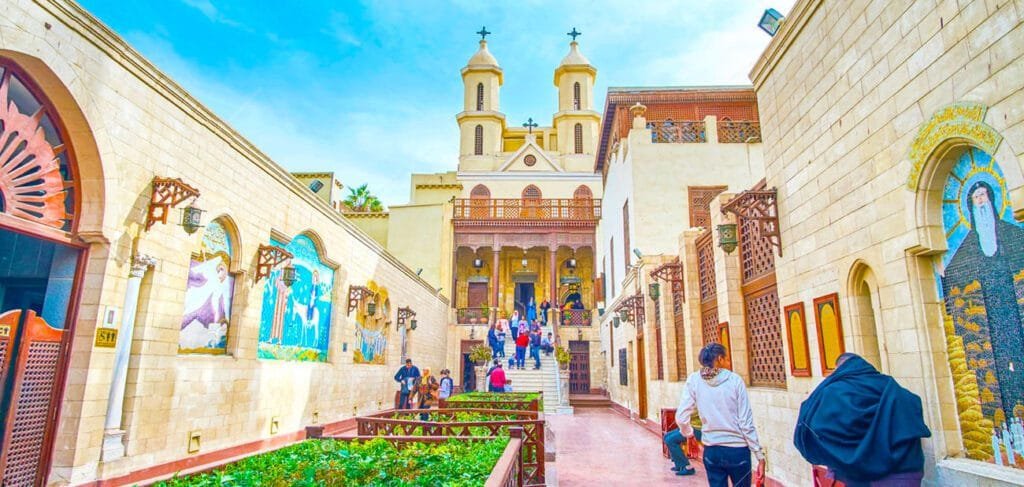
3. Christian Egypt: Coptic Churches and Monasteries
Egypt is home to one of the oldest Christian communities in the world, the Coptic Orthodox Church, which has a rich and deeply rooted history that spans centuries. One of the most significant and iconic Christian landmarks in Cairo is the Hanging Church, also known as the Saint Virgin Mary’s Coptic Orthodox Church. Located above a Roman fortress in the heart of Coptic Cairo, the church is a stunning example of Coptic Christian architecture and a symbol of Egypt’s ancient Christian heritage. The church’s name comes from its elevated position, as it hangs over the remnants of the Roman Babylon fortress. The architecture of the Hanging Church blends influences from Roman, Byzantine, and Coptic styles, creating a unique and beautiful structure. The interior is adorned with intricate wood carvings, beautiful icons, and scenes from Christian history that highlight Egypt’s pivotal role in the early development of Christianity. The Hanging Church remains a vibrant center of worship and reflection for Egypt’s Coptic community and serves as a spiritual haven for visitors seeking to connect with Egypt’s Christian past. Further south in the Eastern Desert, the Monastery of Saint Anthony, founded in the 4th century, is considered one of the first Christian monastic communities in the world. Saint Anthony, regarded as the father of Christian monasticism, retreated to this remote desert location to live a life of asceticism and prayer, inspiring many others to follow his example. The monastery continues to serve as a peaceful and spiritual retreat, offering visitors an opportunity to step away from the bustle of modern life and connect with the early ascetic traditions that shaped Christian monasticism. With its ancient walls and serene surroundings, the monastery provides a powerful sense of history and spiritual calm, making it a place of pilgrimage for those seeking to learn more about the origins of Christian monastic practices. In the Sinai Peninsula, another important Christian site is Saint Catherine’s Monastery, located at the foot of Mount Sinai, where Moses is believed to have received the Ten Commandments. This 6th-century monastery is one of the oldest continuously operating Christian monasteries in the world and is a UNESCO World Heritage site. Saint Catherine’s Monastery is home to a treasure trove of ancient manuscripts, rare icons, and religious relics that chronicle Egypt’s deep Christian history. The monastery’s location, nestled at the base of Mount Sinai, adds to its spiritual significance, as it has long been a destination for Christian pilgrims seeking to connect with the biblical events tied to the mountain. The monastery continues to be a living center of prayer and pilgrimage, where both Coptic Christians and visitors from around the world come to reflect on Egypt’s early Christian heritage and its place in the broader history of Christianity. These Christian landmarks—the Hanging Church, Saint Anthony’s Monastery, and Saint Catherine’s Monastery—are not only important sites of worship but also serve as living reminders of Egypt’s enduring Christian heritage. They continue to be vital centers of faith for the Coptic Orthodox Church, while also drawing pilgrims and visitors from around the world who are interested in exploring the deep spiritual and historical connections between Egypt and the early foundations of Christianity.
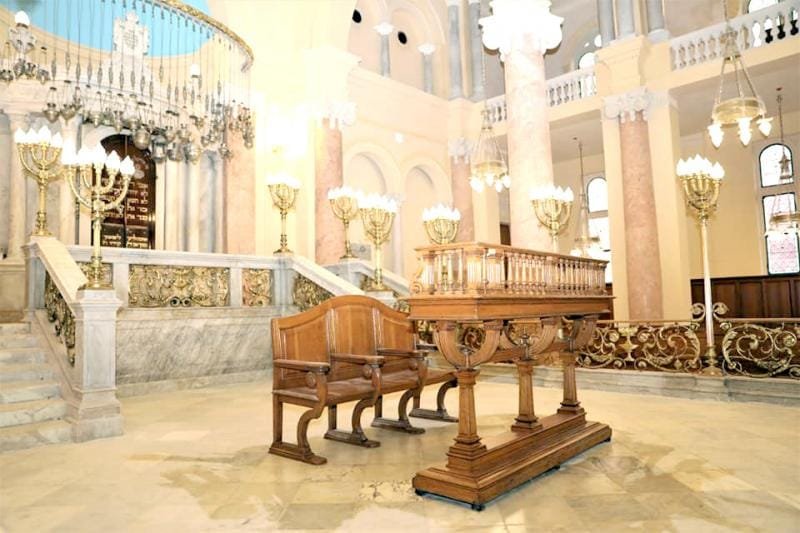
4. Jewish Egypt: Synagogues and Heritage Sites
Although Egypt’s Jewish population has diminished considerably over the years, the country continues to house several significant Jewish heritage sites that offer a glimpse into the once-vibrant Jewish community. One of the most notable of these is the Ben Ezra Synagogue in Cairo, a site rich with historical and spiritual significance. Originally built as a church in the 9th century, the structure was later converted into a synagogue, serving as a place of worship for Jewish communities in Cairo for centuries. Located in the heart of Cairo’s historic old Jewish quarter, the Ben Ezra Synagogue has been an important site for both Jewish religious services and scholarly study. It is particularly famous for the discovery of the Cairo Geniza, a remarkable collection of Jewish manuscripts that were preserved in the synagogue for centuries. The Geniza, which includes texts dating from the 9th to 19th centuries, provides valuable insights into Jewish life, traditions, and commerce in Egypt and beyond, making the Ben Ezra Synagogue an essential landmark for those exploring the history of Jewish Egypt. Another crucial Jewish heritage site is the Alexandria Jewish Cemetery, located in the coastal city of Alexandria. The cemetery offers a poignant connection to the past, with the graves of prominent Jewish families and individuals who once played an important role in Egypt’s political, economic, and cultural spheres. The cemetery’s historical significance lies in its association with Egypt’s Jewish community, many of whom were influential in the country’s business world, government, and intellectual life during the 19th and early 20th centuries. Though Egypt’s Jewish community has dwindled, these heritage sites like the Ben Ezra Synagogue and the Alexandria Cemetery remain vital to preserving the memory of a once-thriving community. For those interested in Egypt's rich, diverse religious history, these sites offer a valuable opportunity for reflection, understanding, and remembrance of the Jewish presence in Egypt.
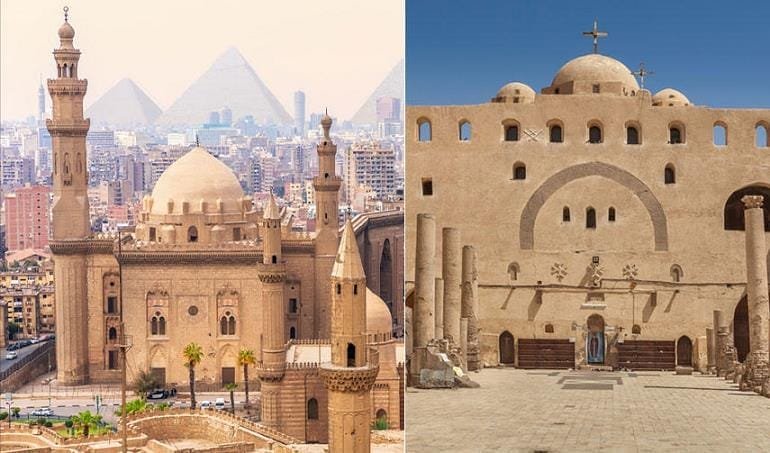
5. The Importance of Pilgrimage and Spirituality
Egypt’s religious sites are much more than historical landmarks; they are living spaces of spirituality, where pilgrims and worshippers from various faiths have sought divine connection for centuries. These sacred places serve as focal points for prayer, meditation, reflection, and spiritual renewal. For example, the ancient Egyptian temples, such as Karnak and Abu Simbel, were designed as divine spaces to honor gods like Amun, Ra, and Ptah. These monumental temples were places where both pharaohs and common people could come together to seek favor from the gods, ensuring prosperity, harmony, and favor in the afterlife. They were not just places of worship but vital components of the social and political fabric, as the pharaohs often used the temples to reinforce their divine rule and legitimacy. For those visiting today, these temples continue to evoke a sense of awe and reverence, offering a profound connection to Egypt's ancient spiritual traditions. For Muslims, Egypt’s mosques play a similarly essential role. The Mosque of Muhammad Ali and Al-Azhar Mosque in Cairo are central to Islamic worship and scholarship. Al-Azhar, founded in the 10th century, is one of the world’s oldest and most respected institutions of Islamic learning. These mosques not only serve as places for daily prayer but also as hubs for intellectual reflection, spiritual practice, and community. They are spaces where visitors can immerse themselves in Islamic culture and seek to deepen their understanding of their faith. Christian visitors find solace in Egypt’s Coptic monasteries, such as those in the Sinai Desert and Nile Valley. These monasteries offer peaceful retreats for those seeking connection to early Christian asceticism, and they provide opportunities to reflect on the lives of the saints and their spiritual journeys. Even Egypt’s Jewish heritage sites, like the Ben Ezra Synagogue in Cairo, offer a spiritual experience, allowing visitors to reflect on the historical and cultural legacy of Egypt’s Jewish community. All of these religious sites offer more than history—they provide a space for spiritual renewal, personal connection, and a deeper appreciation of Egypt’s diverse religious history.
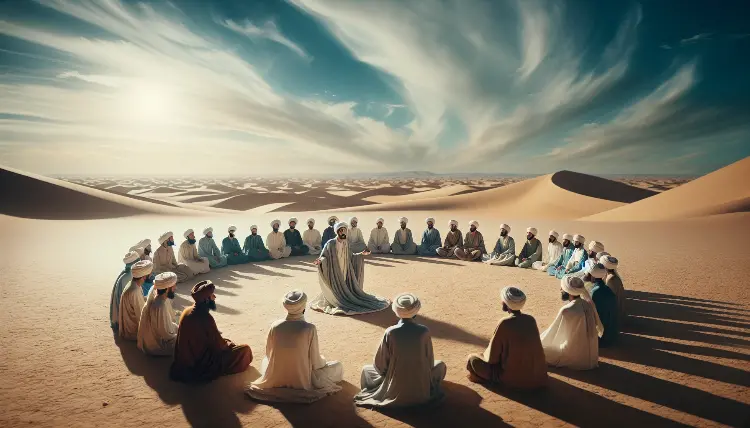
6. The Role of Sufism in Egypt's Spiritual Landscape
Sufism, the mystical branch of Islam, has played a vital role in Egypt’s religious and cultural life for centuries. Sufi practices emphasize a personal connection with the Divine through meditation, prayer, and ritualistic dances, particularly the well-known whirling dervishes. Throughout Egypt, there are numerous Sufi shrines and mosques that are integral to the country's spiritual heritage. The Mosque of al-Hussein in Cairo, for example, is not only a popular mosque but also a significant Sufi site, as it is believed to house the head of Imam Hussein, the grandson of the Prophet Muhammad. Pilgrims from all over the Islamic world come to pay homage here, making it an important center of Sufi spirituality. The Sufi Festival of Egypt, held annually in Cairo, is another example of the country’s deep connection to mystical Islam. During the festival, thousands of Sufi followers gather to engage in rituals, music, and dancing, all designed to bring participants closer to God through spiritual ecstasy. The al-Azhar University in Cairo, renowned for its Islamic scholarship, is also known for its Sufi teachings and practices, which continue to influence the broader Islamic world. Many of Egypt’s Sufi orders, such as the Qadiri, Shadhili, and Rifa’i, have their roots in the country, and their teachings permeate Egypt’s social and spiritual life. Sufism in Egypt is not only about the pursuit of personal closeness to God but also about community, with gatherings that foster a sense of unity and brotherhood. These Sufi sites and practices highlight the diverse expressions of Islamic spirituality that have enriched Egypt’s religious history, offering both locals and visitors a path to deeper, more personal faith.


